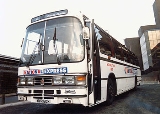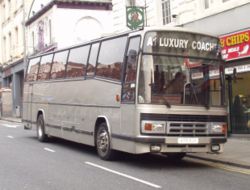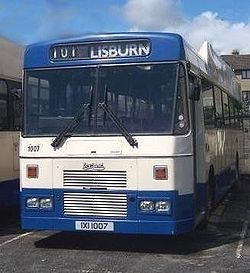
Leyland Tiger
Encyclopedia

Leyland Leopard
The Leyland Leopard was a mid-engined single-deck bus and coach chassis built by Leyland between 1959 and 1982. It was popular with bus and coach operators throughout the British Isles...
, which had been in production for over 20 years. Leyland's then-competitor Volvo, having already won over many independent customers from Leyland with its successful B58
Volvo B58
The Volvo B58 is a mid-engined bus chassis built by Volvo of Sweden from 1966 until early 1982. It was the forerunner to the highly successful B10M....
, was at the time developing the B10M
Volvo B10M
The Volvo B10M is a popular mid-engined bus and coach chassis built by Volvo between 1978 and 2001. It was built as the successor of the B58 and was equipped with a 9.6-litre horizontally-mounted Volvo THD100/THD101/THD102/THD103/THD104/DH10A diesel engine mounted under the floor, near the middle...
, which was set to further strengthen its position in the coach industry.
Engine options
Initially only one engine was offered, the turbocharged Leyland TL11, which could be rated up to 245 hp. The Leopard had enjoyed huge success as a bus in Scotland, usually with the Alexander Y-type body, but had lost some Scottish Bus GroupScottish Bus Group
The Scottish Bus Group was a state-owned Scottish holding company that included a number of bus operators covering the whole of Scotland. The group was formed in 1961 as Scottish Omnibuses Group Ltd, to take control of the British Transport Commission's bus operating subsidiaries in Scotland...
orders to Seddon's
Seddon Atkinson
Seddon Atkinson Vehicles Limited, a manufacturer of large goods vehicles based in Oldham, Greater Manchester, England, was formed in mid 1970 when Atkinson Vehicles Limited of Preston was acquired by Seddon Diesel Vehicles Limited of Oldham...
Pennine VII, owing to Leyland's unwillingness to offer a Gardner engine in the Leopard. When Leyland launched the Tiger, it continued this same unwillingness, just as Dennis was developing the Gardner-engined Dennis Dorchester
Dennis Dorchester
The Dennis Dorchester was a mid-engined heavy-duty single deck coach or bus chassis built by Dennis in small numbers between 1983 and 1988.About two thirds of the total number built were bought by Scottish Bus Group subsidiaries Western Scottish, Central Scottish and Clydeside Scottish...
, which similarly had the potential to win SBG orders away from the Tiger. Faced with this possibility, Leyland offered Gardner 6HLX-series engines in the Tiger from 1984. To facilitate this, the Tiger chassis had to be modified, as the Gardner engine was significantly larger than the TL11. Although the threat from the Dorchester was successfully warded off, there proved to be a limited market for the Gardner-engined Tiger outside of SBG.
A North American engine, the Cummins
Cummins
Cummins Inc. is a Fortune 500 corporation that designs, manufactures, distributes and services engines and related technologies, including fuel systems, controls, air handling, filtration, emission control and electrical power generation systems...
L10, was also made an option by 1987. (Cummins' previous attempt to put its engines in a British bus had not been a success; they were used in the notoriously unreliable Daimler Roadliner
Daimler Roadliner
The Daimler Roadliner was a single deck bus or coach chassis built by Daimler between 1962 and 1972. Notoriously unreliable, it topped the 1993 poll by readers of Classic Bus as the worst bus type ever, beating the Guy Wulfrunian into second place...
.) Engine design and development was very expensive, and Leyland was no longer a world leader in this field, so outsourcing was the only option if Leyland wanted modern engines in its coaches. The Cummins engine was being specified more often from around 1988, and with this engine, the gearbox would usually be a ZF
ZF Friedrichshafen
ZF Friedrichshafen AG, also known as ZF Group, and commonly abbreviated to ZF, is a German public company headquartered in Friedrichshafen, in the south-west German region of Baden-Württemberg....
as opposed to the Leyland Hydracyclic.
Volvo took over Leyland in 1988, and from 1989 the Tiger was offered with the Volvo THD100-series engine (as fitted in the best-selling B10M). The large majority of Volvo-engined Tigers went to Northern Ireland
Northern Ireland
Northern Ireland is one of the four countries of the United Kingdom. Situated in the north-east of the island of Ireland, it shares a border with the Republic of Ireland to the south and west...
. At around this time, the TL11 and Gardner options were dropped, leaving only the Cummins and Volvo options available.
Bus version


Walter Alexander Coachbuilders
Walter Alexander Coachbuilders was a Scottish bus coachbuilder and operater based in Falkirk.-History:Walter Alexander, notice a lack expasion by the Falkirk and District Tramways Company's especially in to Grangemouth which never hdd a tram line. In 1913 Alexander's Motor Service was created to...
TS-type bodywork and Gardner 6HLXCT engines. Small independent operators also took an interest in the Tiger as a bus. Bodywork for the Tiger bus was built by Alexander (the T-type and P-type), Duple
Duple Coachbuilders
Duple was best known as a British manufacturer of coach and bus bodywork from 1919 until 1989.-History:Duple Bodies & Motors Ltd was formed in 1919 by Herbert White in Hornsey, London...
(Dominant Bus, 300), Plaxton
Plaxton
Plaxton is a builder of bus and coach vehicle bodies based in Scarborough, England.-History:The Plaxton of today is the successor to a business founded in Scarborough in 1907 by Frederick William Plaxton.-Beginnings:...
(Bustler and Derwent), East Lancs (some of which were rebodies), Wadham Stringer and Reeve Burgess
Reeve Burgess
Reeve Burgess was a bus body manufacturer based in Pilsley, North East Derbyshire in the United Kingdom. It was a subsidiary of Plaxton from 1980 until its closure in 1991....
(who built an unusual batch of short Tigers for Tayside).
The Tiger also proved to be very popular in Northern Ireland, with Ulsterbus
Ulsterbus
Ulsterbus is a public transport operator in Northern Ireland and operates bus services outside Belfast. It is part of Translink , which also includes Northern Ireland Railways, Metro Belfast and Flexibus.-Services:Ulsterbus is responsible for most of the province-wide bus...
and Citybus (known as Metro since February 2005) purchasing 747 between 1983 and 1993. Approximately 157 are still in service as of January 2010, compared to 576 in 2007. 7 are N-Types (with seven others being used as towbuses) and 150 are Q-Types including 10 bodied Wright Endeavour. The number of N-Type Tigers left with Ulsterbus and Citybus have decreased significantly in the past few years, as fleet numbers 340-499, 1000-1339, and Gardner
L. Gardner and Sons Ltd.
L. Gardner and Sons Ltd was a well-known British builder of diesel engines for stationary, marine, road and rail applications. The company was founded in Hulme Manchester England in 1868. They started building engines around 1895. The firm of L...
-engined 2601-2635 have been withdrawn. All in an attempt to 'modernise' the Ulsterbus and Citybus (Metro) fleet. As of January 2010, only the Volvo engined Tigers remain in active service as all Gardner and Leyland engined Tigers have been withdrawn. However, apart from being scrapped, many of these vehicles have been sold on to other operators and preservationists. The first Tiger bus to arrive in Northern Ireland was registered DXI 3340 (fleet number 340), new in January 1984 with Ulsterbus (six Tiger coaches were already in the fleet). A body for this type of bus was built in Mallusk, Northern Ireland
Newtownabbey
Newtownabbey is a large town north of Belfast in County Antrim, Northern Ireland. Sometimes considered to be a suburb of Belfast, it is separated from the rest of the city by Cavehill and Fortwilliam golf course...
by Alexander (Belfast), known as the N-Type. Initially, Ulsterbus used the TL11 engine, whilst Citybus used the TRB6LXB Gardner engine on its 1988-89 batches of Tigers with LXI and NXI registrations. The N-Type body ceased production in September 1990, with the last one arriving in Northern Ireland registered RXI 3339 (fleet number 1339. This historical bus was subsequently withdrawn and sold for scrap in April 2007.) It was then replaced by the Q-Type body, which was built on Tigers 1321, 1340-1500 and 2636-2680 up until August 1993 (and thereafter on its successor the Volvo B10M
Volvo B10M
The Volvo B10M is a popular mid-engined bus and coach chassis built by Volvo between 1978 and 2001. It was built as the successor of the B58 and was equipped with a 9.6-litre horizontally-mounted Volvo THD100/THD101/THD102/THD103/THD104/DH10A diesel engine mounted under the floor, near the middle...
for a further two years). These later Ulsterbus Tigers (fleet numbered 1300-1500) and Citybus Tigers (2636-2680) were fully automatic and were equipped with a Volvo engine. The first of the Q-Types, which was a prototype
Prototype
A prototype is an early sample or model built to test a concept or process or to act as a thing to be replicated or learned from.The word prototype derives from the Greek πρωτότυπον , "primitive form", neutral of πρωτότυπος , "original, primitive", from πρῶτος , "first" and τύπος ,...
, also came to Northern Ireland, registered RXI 3321 (fleet number 1321) in December 1990. The very last Tiger to enter service did so in Northern Ireland, this being registered YXI 5500 (fleet number 1500) in August 1993.
The Tiger was very popular in Australia
Australia
Australia , officially the Commonwealth of Australia, is a country in the Southern Hemisphere comprising the mainland of the Australian continent, the island of Tasmania, and numerous smaller islands in the Indian and Pacific Oceans. It is the world's sixth-largest country by total area...
as well, with many units entering NSW fleets. The biggest customer for the Tiger in Australia was arguably Ventura in Melbourne who purchased around 70 Tigers over a four year period. All but one of these units carry a Pressed Metal Corporation body built in Sydney, but there is one with a PMC Adelaide body built in South Australia which was purchased second hand. These Tigers began to arrive at Ventura in April 1984 and the last batch was delivered in October/November 1987 but did not get registered or enter service until early 1988. These buses are now withdrawn from service from Ventura, with a small number living on for school bus
School bus
A school bus is a type of bus designed and manufactured for student transport: carrying children and teenagers to and from school and school events...
duties only.
Many Tigers are in operation by the NSW bus company, Premier Illawarra who possesses around 30-40 of these vehicles in relatively good condition for their age.
Volvo ownership
Leyland BusLeyland Bus
Leyland Bus was a British bus manufacturer. It emerged from the Rover Group as a management buyout of the bus business...
was acquired by a management buyout led by Ian McKinnon in January 1987, and it looked like the Tiger would continue as before. Just over 12 months later Volvo purchased the business, bringing Britain
United Kingdom
The United Kingdom of Great Britain and Northern IrelandIn the United Kingdom and Dependencies, other languages have been officially recognised as legitimate autochthonous languages under the European Charter for Regional or Minority Languages...
's two best-selling coaches, the Volvo B10M and Leyland Tiger, under common ownership. Volvo was aware that Leyland had a loyal following, and that the Tiger had a good reputation, and so the Tiger continued. In 1989, despite slow sales, it reassured Tiger loyalists that the chassis was there to stay, positioning it to compete with the Dennis Javelin
Dennis Javelin
The Dennis Javelin is an underfloor-engined bus and coach chassis originally built by Dennis in the United Kingdom. It was unveiled in 1986 and acted more or less as a modern replacement for the discontinued Bedford Y-series...
. But sales remained slow, and in 1990, in an attempt to shift stock, Volvo had Plaxton body forty chassis. Twenty-five of these bodies were the only Plaxton 321 bodies built, this being the Plaxton derivative of the Duple 320 body acquired when Duple closed.
Volvo acknowledged that the Tiger and B10M were broadly similar, and whereas Leyland had sold 3,500 Tigers since the model's launch, Volvo had sold 20,000 B10Ms during the same period. The penultimate major buyer of the Tiger, Shearings, switched to the B10M for 1991, and Volvo finally decided to cease production on the same date as the factory that built it, in Farington
Farington
Farington is a small village and civil parish in the South Ribble local government district of Lancashire, England.-Geography:Situated to the immediate north of Leyland, Farington consists of villages, farms and mossland, modern residential development and an industrial area around the Leyland...
, closed.

